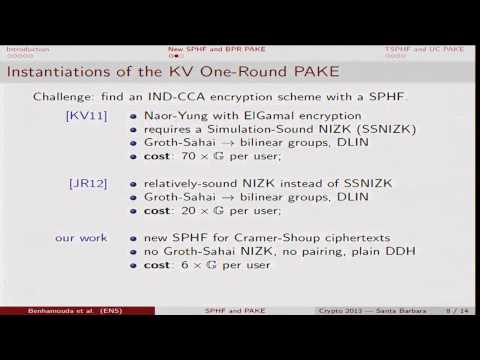Welcome to the resource topic for 2015/188
Title:
New Techniques for SPHFs and Efficient One-Round PAKE Protocols
Authors: Fabrice Benhamouda, Olivier Blazy, Céline Chevalier, David Pointcheval, Damien Vergnaud
Abstract:Password-authenticated key exchange (PAKE) protocols allow two players to agree on a shared high entropy secret key, that depends on their own passwords only. Following the Gennaro and Lindell’s approach, with a new kind of smooth-projective hash functions (SPHFs), Katz and Vaikuntanathan recently came up with the first concrete one-round PAKE protocols, where the two players just have to send simultaneous flows to each other. The first one is secure in the Bellare-Pointcheval-Rogaway (BPR) model and the second one in the Canetti’s UC framework, but at the cost of simulation-sound non-interactive zero-knowledge (SSNIZK) proofs (one for the BPR-secure protocol and two for the UC-secure one), which make the overall constructions not really efficient. This paper follows their path with, first, a new efficient instantiation of SPHF on Cramer-Shoup ciphertexts, which allows to get rid of the SSNIZK proof and leads to the design of the most efficient one-round PAKE known so far, in the BPR model, and in addition without pairings. In the UC framework, the security proof required the simulator to be able to extract the hashing key of the SPHF, hence the additional SSNIZK proof. We improve the way the latter extractability is obtained by introducing the notion of trapdoor smooth projective hash functions (TSPHFs). Our concrete instantiation leads to the most efficient one-round PAKE UC-secure against static corruptions to date. We additionally show how these SPHFs and TSPHFs can be used for blind signatures and zero-knowledge proofs with straight-line extractability.
ePrint: https://eprint.iacr.org/2015/188
Talk: https://www.youtube.com/watch?v=zIGTe8bdQag
See all topics related to this paper.
Feel free to post resources that are related to this paper below.
Example resources include: implementations, explanation materials, talks, slides, links to previous discussions on other websites.
For more information, see the rules for Resource Topics .
